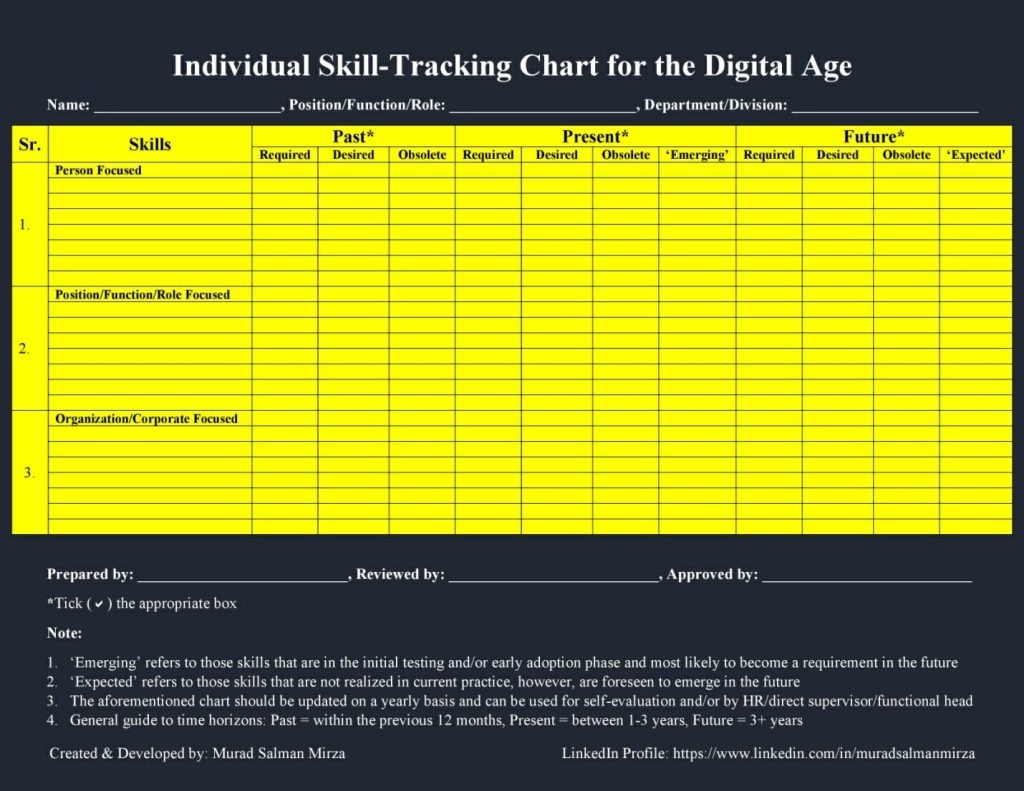There was a time when graduating from a reputable academic institution was the first step to a safe professional journey, with a steady climb up the corporate ladder culminating in a respectable retirement from a grateful organization. However, as analog initiatives have increasingly yielded to digital pursuits, business lifecycles have become increasingly susceptible to disruptive technologies. Once secure careers grow less secure each day.
Gaining a degree is no longer considered essential for success in an era when college dropouts receive rock star status in the startup world. This is being reinforced by the influx of MOOCs (Massive Open Online Courses) and core emphasis on specific skills, rather than, broad educational credentials.
The key for astute professionals is to never starve a positive mindset by failing to engage in an honest self-assessment of professional prowess. In this context, the individual skill-tracking chart is being presented as a proactive tool for professionals to avoid irrelevancy in the changing corporate environment.
The chart provides a guide for the type of learning and development imperatives professionals – and especially those in mid-career – must consider to remain relevant.
Following are some of the main exploratory questions that can be used in formulating the chart:
- What are the comprehensive skills required for this person to do the assigned position in an efficient and effective manner?
- What were the past skill requirements and expectations for this position and are they still relevant?
- What are the current skill requirements and expectations for this position and will they stay relevant in the future?
- Are there any emerging skills likely to become a requirement in the future?
- What will be the future skill requirements and expectations for this position and do they differ from present requirements?
- Are there any skills that were required in the past that are now simply desired?
- Are there any skills that are required now that used to be desired in the past?
- Are there any desired skills now that may become a requirement in the future?
- Have any skills considered obsolete earlier become relevant again?
- Are there any skills that are considered obsolete now liable to be relevant again in the future?
- Are there any skills that have remained consistently in demand?
- Do the skill sets facilitate the conduct of a comprehensive and effective performance appraisal?
- Has the percentage of skills that can be reinforced/enhanced using blended learning increased over time?
- Has the percentage of obsolete skills increased over time?
- Has the percentage of required skills increased over time?
- Has the percentage of desired skills increased over time?
- Is the nature of this position going to change in the future?
- Will this position exist in the future?
- In the future, will this position gain more significance?
- Will this position lose its current level of significance?
- Does this position overlap significantly with another position in terms of skill sets?
- Can this position be easily merged with another position/role?
- Can the talent pipeline for succession planning initiatives be reinforced with the skill sets reflected in the chart?
- Which is the most relatable/closest position that can accommodate a person doing this position if it is eliminated?
- Can the respective chart be used in a benchmarking study with closely matching/similar positions/roles of competitors/industry leaders/trendsetters?
The aforementioned questions enable the user to prepare for prolonging their usefulness as a qualified, committed and needed professional. It’s time we challenged that unfortunate adage: “Everyone is expendable.”
